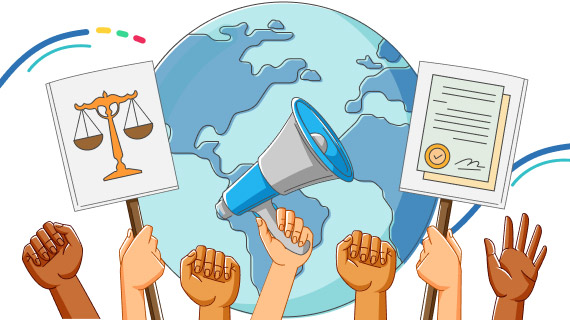In a previous article we took a closer look at technology and its potential to contribute to the realization of human rights. Now, we are interested in discussing the understanding of human rights and analyzing how they can be integrated with technology.
What are human rights?

Human rights have been the subject of different definitions and concepts over time, which have varied according to the theoretical and political positions from which they are analyzed. Thus, it is possible to identify conceptions from iusnaturalism, iuspositivism, liberalism, Marxism, etc. Although these debates are interesting, the purpose of this article is not to analyze the conceptions of human rights. In that sense, it is considered that critical theories and those that understand them as moral rights allow us to have a more accurate understanding of how they are linked to technology.
According to the renowned author Ruiz Miguel, the existence of human rights (or of any human right) presupposes at least three conceptual features:
“that human rights are (a) justified ethical requirements, (b) particularly important, and (c) to be effectively protected, in particular through the legal apparatus.”2
Three characteristics emerge from this concept. On the one hand, it is pointed out that they are justified ethical demands. By pointing out that they are demands, the correlativity that exists between the attribution to someone of a right and the obligation to respect it is identified. It is also postulated as justified ethics, understanding ethics as the set of moral norms that direct or value human behavior in a community. Furthermore, it is suggested that this justification derives from a rational argumentation based on certain moral principles that serve as the foundation of these demands and are related to the other characteristic features of human rights.
Under this conception, it is not enough that they are justified ethical requirements, but they must be of a certain type, which is why it is pointed out that they are especially important. Thus, it is argued that they deal with goods that -usually- are of fundamental importance for the holder and hence derive their force, such as human dignity or life.
Finally, the stipulation that they must be effectively protected, in particular through the legal apparatus, points to the need for legal mechanisms to demand their respect (laws, procedures, institutions, etc.). This understanding does not limit human rights only to those recognized in treaties, conventions or laws, but demands that legal norms legislate them so that they can be protected with greater force. Thus, it recognizes that other justified and important ethical demands can be conceived as human rights, even if they have not been recognized in legislation.
How do human rights currently relate to technology?

From the above, the plural and constant construction of human rights can be identified. We must bear in mind that, after the fall of the Soviet Union bloc, human rights have become one of the hegemonic discourses worldwide. Without wishing to enter into the debate on whether or not human rights are a discourse that sustains economic, political and social power, the fact is that many rights that decades – or centuries – ago were not understood as such, are now important requirements for human life. In other words, the understanding and scope of a right can change over time.
In this continuous process of construction – and deconstruction – of human rights, technology can play a fundamental role in their respect and protection. One example is the right to access to information.
Several theories of the State refer to the obligation of transparency and accessibility of data and public information, even since medieval times. However, it was not until the 1970s that the Right of Access to Information began to be discussed with greater determination. It should be noted that, also at this time, information and communication technologies began to have a greater impact on society.
Although there are no specific international conventions or treaties on the right of access to information, this is a cross-cutting constant in most international human rights instruments. Thus, the International Covenant on Civil and Political Rights 3 establishes in Article 19 that
No one shall be subjected to interference with his opinions and that everyone has the right to freedom of expression, which includes freedom to seek, receive and impart information and ideas of all kinds regardless of frontiers.
In turn, the American Convention on Human Rights 4 , establishes in Article 13 that everyone has the right to freedom of thought and expression. Like the UN Covenant, it establishes that this right includes the freedom to seek, receive and impart information and ideas of all kinds regardless of frontiers, whether orally, in writing or in any artistic form, and by any means. Important references can also be found in the European Convention for the Protection of Human Rights and Fundamental Freedoms (art. 10 and 8) 5 , in the resolutions of the Parliamentary Assembly of the Council of Europe, but above all in the extensive case law of the European Court of Human Rights.
Likewise, a study by the Office of the Special Rapporteur for Freedom of Expression of the Inter-American Commission on Human Rights 6 states that,
In 2006, more than 65 countries around the world passed laws establishing mechanisms for public access to information. This is a trend that has only grown in the last 6 years, given that at least 28 of these laws have been enacted since 2000. 7

In this context, the right of access to information is becoming more and more relevant within the social demands, and this increase in its demand is accompanied by the advance of information and communication technology. In fact, the jurisprudence and regulations on access to information emphasize the development of mechanisms that allow the population to have access to data in a quick, timely, orderly, transparent, updated and easily available manner. Characteristics that -certainly- can and demand the use of technologies that allow exercising and guaranteeing this right.
Similarly, examples can be found in other rights such as due process, access to justice, etc., in which the State is required to have suitable means to provide prompt, timely and accessible justice for all persons. This requirement demands, in turn, shorter deadlines and expeditious means of communication and inter-institutional coordination, in order to provide a justice service that responds to human rights.
Technologies also play a fundamental role in guaranteeing respect for these rights.
Now, we would like to look at some experiences that identify the impact that technologies can have on human rights, such as in Juvenile Justice. For that, we invite you to read the following Blog in which we analyze these examples.
1 Lawyer and Master in Human Rights and Democracy by the Latin American Faculty of Social Sciences of Mexico: Expert in Juvenile Justice and human rights of Fundación Tutator.
2 Ruiz Miguel, Alfonso (1990), “Los derechos humanos como derechos morales”, Anuario de Derechos Humanos, No. 6, p. 152.
3 Adopted by the United Nations General Assembly on December 16, 1966.
4 Approved by the Organization of American States on November 22, 1969.
5 Opened for signature by the Council of Europe in 1950 and in force since 1953.
6 Some cases of the European Court on Access to Information are: Leander v. Sweden, Gaskin v. United Kingdom, Guerra and Others v. Italy, and Open Door and Dublin Well Woman and Others v. Ireland, among others.
7 IACHR, Inter-American Commission on Human Rights and Office of the Special Rapporteur for Freedom of Expression (2007). “Special Study on Access to Information”, Organization of American States, Washington, p. 12.
